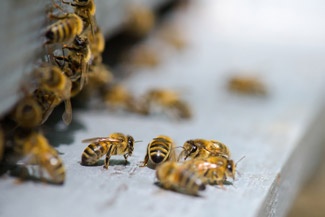Is our brain like a bee colony?
 Besides the need to protect them because they play a fundamental role in pollination (which is essential to the survival of many plant and animal species), bees can tell us a lot about how our brains work. A research team from Sheffield studied their behavior and discovered analogies to the way our neurons interact during the decision-making process. How can a colony of bees be related to the human brain?
Besides the need to protect them because they play a fundamental role in pollination (which is essential to the survival of many plant and animal species), bees can tell us a lot about how our brains work. A research team from Sheffield studied their behavior and discovered analogies to the way our neurons interact during the decision-making process. How can a colony of bees be related to the human brain?A colony of honeybees works as a whole; each of its members depends on the others for survival. This specificity, also found in ants, intrigued scientists, especially those interested in psychophysics. This science studies the links between physical stimuli and the resulting sensations they produce and tries to establish laws that govern the relationship between body and mind.
The research team produced a theoretical model of how bees decide where to build their nest. In the spring, the queen leaves her nest with thousands of bees. Part of the swarm protects her, while the other part determines the best place to build a hive. This is a very organized decision-making process: bees explore the environment and after locating a potential site, they come back to the swarm to recruit other scouts, communicating through what is known as the dance of the bees. In the end, the colony makes a decision by following three psychophysical laws that can be applied in the same manner to the human brain's decision-making process.
The first law, Pieron’s law, says that we decide more quickly if the two options available to us are of high quality. On this point, Andreagiovanni Reina and his colleagues showed that the bee colony is indeed quicker to decide between two nesting locations if they are both very suitable compared to two low-quality sites. The second law, Hicks law, states that as the number of possibilities increases, so does the length of the decision-making process. In their study, the researchers also observed that the more alternatives were available, the slower the bees were in choosing the location of the hive. The third law, Weber’s law, explains that there is a linear relationship between our decision-making and the differences in minimum qualities required between all available options. Basically, the law states that, to be detected, greater differences are required between low quality sites than high quality ones.
In conclusion, observing bees sheds light on the mechanisms that govern our decision-making process. This study should allow scientists to better understand the basic principles that generate the psychophysical law that we have just presented. According to A. Reina: “studying nest selection in bees is much simpler than watching brain neurons in action when a decision is being made." And research synergies between neuroscience and collective intelligence could help us to understand these mechanisms even better...
Source: Andreagiovanni Reina, Thomas Bose, Vito Trianni, James AR Marshall, “Psychophysical Laws and the Superorganism”, in Scientific Reports, March 2018







